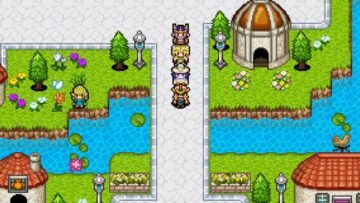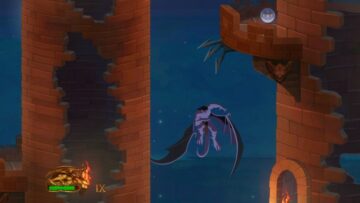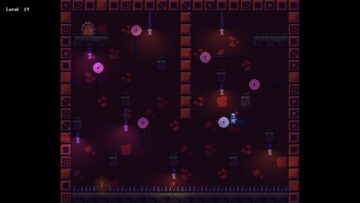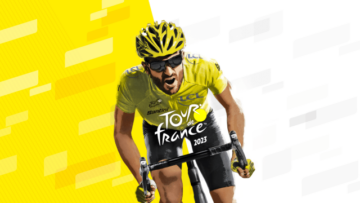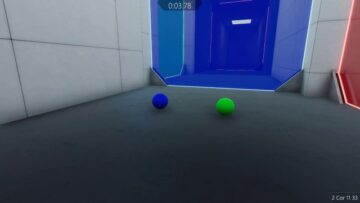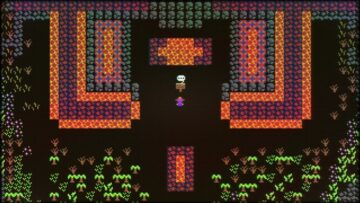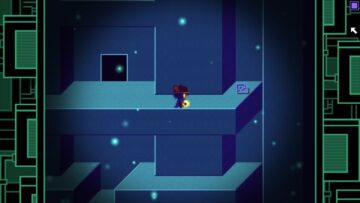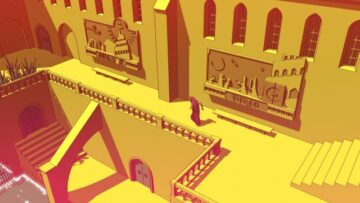They say imitation is the finest form of flattery (probably). Paying tribute to the classics is nothing new, but the best homages usually put their own spin on things. No prizes for guessing which game Panic Porcupine is inspired by then.
That’s right, it’s Sonic The Hedgehog! This is briefly referenced early on in Panic Porcupine, where a picture of a rather muscular Sonic is hung on the wall and a throwaway comment is mentioned about him shooting a movie. However, the similarities don’t end there.
Panic Porcupine is a retro style platformer which looks like it would have been right at home on the Sega Mega Drive. It’s pretty straightforward; you take control of Panic as you zip through over fifty levels split across six worlds in a bid to save the chickabirbs and defeat the evil Dr. Proventriculus.
Rather oddly, Panic Porcupine is all about avoiding hazards when platforming, as there are no enemies to dispatch as you play through each level. Instead you’ll have to avoid buzzsaws, time your jumps well between moving platforms and build up enough speed to clear loop-de-loops. Think more along the lines of Super Meat Boy and you’ll get the idea.
Each of the worlds has several stages to clear, and a boss battle to round things off. These are fairly simple encounters where Panic will need to smash several rotating orbs to take down Dr. Proventriculus. That’s pretty much all there is to it.
Now, the first issue I came up against with Panic Porcupine was how the rapid rodent handles. This is a game designed to test your platforming skills, and also aims to ensure you die time and time again (it’s a good job you’re given unlimited lives from the outset then). But Panic manages to be over and under sensitive to your inputs at the same time. I also encountered some lag when trying to jump, for example, meaning I walked straight into a spike pit many, many times.
There are also some platforming elements which attempt to mix things up a bit, but end up feeling utterly frustrating. Panic can spin on poles and you’ll need to time your jump carefully to move the right way. He can also spin around circular platforms to generate lift and access higher areas. Both are hit and miss, and you’ll be absolutely sure you timed your move perfectly only to go the wrong way and hurtle towards a premature death.
Accuracy is demanded of you as the levels get increasingly challenging but it feels a little bit like a lottery as to whether you can successfully navigate them or not. Frustration set in early for me, not because of the challenge, but instead in regards how clunky the controls felt. It plays much worse than its predecessor, released over thirty years ago.
However, as I alluded to at the top of my review, it’s the heavy borrowing of ideas which I struggled with the most when playing Panic Porcupine. Whether it’s the level design, platforming mechanics, character elements or simply the look and feel of the game, there’s no denying it has borrowed pretty much everything on offer here. The lack of originality is quite staggering.
Panic Porcupine looks the part, but doesn’t do anything particularly new or exciting. Visually it borrows heavily once again from Sonic, even down to the theme for many of the worlds (remember bouncing around in a giant pinball machine in Sonic The Hedgehog II?). Even the name of the first zone has pretty much the same name.
The soundtrack is catchy enough but again, even some of the sound effects (such as when Panic jumps, or when you hit a metal ball) are almost identical to those seen in the blue hedgehog’s adventures. Everywhere you turn, it’s impossible not to be reminded of the source material.
What results in the end is a sub par, almost clone, of Sonic the Hedgehog that because of the consistent and blatant similarities, cannot escape comparisons to the 90’s classic. Panic Porcupine feels like a bootleg copy of it at times, which as you may expect, struggles to match it in terms of quality.
Panic Porcupine is a run of the mill platformer which cannot escape the shadow of that which inspired it. A problem all of its own making.
- SEO Powered Content & PR Distribution. Get Amplified Today.
- PlatoAiStream. Web3 Data Intelligence. Knowledge Amplified. Access Here.
- Minting the Future w Adryenn Ashley. Access Here.
- Buy and Sell Shares in PRE-IPO Companies with PREIPO®. Access Here.
- Source: https://www.thexboxhub.com/panic-porcupine-review/
- 1
- a
- About
- absolutely
- access
- across
- again
- Against
- ago
- AI
- aims
- All
- along
- also
- and
- Anything
- ARE
- areas
- around
- as
- At
- avoid
- ball
- Battle
- BE
- because
- been
- BEST
- between
- Bit
- Blue
- borrowed
- Borrowing
- both
- build
- but
- by
- came
- CAN
- carefully
- challenge
- challenging
- Classic
- classics
- clear
- comment
- consistent
- content
- Control
- controls
- death
- demanded
- Design
- designed
- Dispatch
- do
- down
- drive
- Early
- effects
- elements
- end
- enough
- ensure
- escape
- even
- everything
- Everywhere
- Example
- Exciting
- expect
- feel
- Finest
- First
- For
- form
- from
- frustrating
- game
- generate
- Get
- giant
- given
- go
- good
- Handles
- has
- Have
- he
- heavily
- heavy
- here
- higher
- HIT
- Home
- How
- however
- HTTPS
- i
- idea
- ideas
- identical
- ii
- impossible
- in
- increasingly
- inputs
- inspired
- instead
- into
- Is
- issue
- IT
- ITS
- Job
- jpg
- jump
- lack
- Level
- levels
- like
- Little
- lives
- Look
- looks
- lottery
- machine
- Making
- many
- Match
- May
- meaning
- Meat
- Mechanics
- metal
- more
- most
- move
- movie
- moving
- much
- name
- navigate
- need
- New
- no
- not
- nothing
- of
- off
- offer
- on
- once
- only
- or
- Orbs
- originality
- over
- own
- Panic
- part
- particularly
- paying
- picture
- Platformer
- Platforms
- plato
- plato data intelligence
- platodata
- platogaming
- play
- Playing
- plays
- pretty
- prizes.
- probably
- Problem
- put
- quality
- quite
- rapid
- rather
- regards
- released
- Remember
- Results
- Retro
- review
- right
- round
- Run
- same
- save
- say
- seen
- Sega
- SEGA Mega Drive
- sensitive
- set
- several
- Shadow
- shooting
- similarities
- Simple
- Simply
- SIX
- skills
- Smash
- some
- Sonic
- Sonic The Hedgehog
- sound
- Soundtrack
- source
- speed
- Spin
- split
- stages
- straight
- straightforward
- style
- successfully
- such
- Take
- terms
- test
- than
- that
- The
- The Game
- The Source
- their
- Them
- theme
- then
- there
- These
- things
- think
- this
- those
- Through
- time
- times
- to
- top
- towards
- turn
- under
- up
- usually
- Wall
- was
- way
- well
- when
- where
- whether
- will
- with
- Worlds
- worse
- would
- wrong
- years
- you
- your
- zephyrnet

